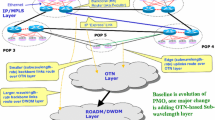Abstract
With the expansion of services offered over the Internet, the “last mile” bottleneck problems continue to exacerbate. A passive optical network (PON) is a technology viewed by many as an attractive solution to this problem. In this study, we propose the design and analysis of a PON architecture which has an excellent performance-to-cost ratio. This architecture uses the time-division multiplexing (TDM) approach to deliver data encapsulated in Ethernet packets from a collection of optical network units (ONUs) to a central optical line terminal (OLT) over the PON access network. The OLT, in turn, is connected to the rest of the Internet. A simulation model is used to analyze the system’s performance such as bounds on packets delay and queue occupancy. Then, we discuss the possibility of improving the bandwidth utilization by means of timeslot size adjustment, and by packet scheduling.
Similar content being viewed by others
References
G. Pesavento, M. Kelsey, PONs for the broadband local loop, Lightwave, PennWell, vol. 16,no. 10, (September 1999), pp. 68-74.
B. Lung, PON architecture “futureproofs” FTTH, Lightwave, PennWell, vol. 16,no. 10, (September 1999), pp. 104-107.
W. Leland, M. Taqqu, W. Willinger, D. V. Wilson, On the self-similar nature of ethernet traffic (extended version), IEEE/ACM Transactions on Networking, vol. 2,no. 1, (February 1994), pp. 1-15.
L. Kleinrock, On flow control in computer networks, Proc. of ICC'78, vol. 2, (Toronto, Ontario, June 1978), pp. 27.2.1-27.2.5.
B. Mukherjee, Optical Communication Networks, (McGraw-Hill, New York, 1997).
W. Willinger, M. Taqqu, A. Erramilli, A bibliographical guide to self-similar traffic and performance modeling for modern high speed networks, in Stochastic Networks: Theory and Applications in Telecommunication Networks (F. P Kelly, S. Zachary, and I. Ziedins, eds.), vol. 4 of the Royal Statistical Society Lecture Notes Series, (Oxford University Press, Oxford, 1996).
J. Hammond, P. O'Reilly, Performance Analysis of Local Computer Networks, (Addison-Wesley Publishing Co., Reading, MA, 1986).
P. M. Fiorini, On modeling concurrent heavy-tailed network traffic sources and its impact upon QOS, Proc. of ICC'99, vol. 2, (Vancouver, June 1999), pp. 716-720.
W. Willinger, V. Paxson, M. Taqqu, Self-similarity and heavy tails: Structural modeling of network traffic, A Practical Guide to Heavy Tails: Statistical Techniques and Applications, R. Adler, R. Feldman, M. S. Taqqu, eds. (Birkhauser, Boston, 1998).
K. Park, W. Willinger, Self-similar traffic: An overview, (Preprint.) To appear in Self-Similar Network Traffic and Performance Evaluation, (Wiley-Interscience, 2000).
W. R. Stevens, TCP/IP Illustrated, Volume 1, (Addison-Wesley Publishing Co., Reading, MA, 1994).
Author information
Authors and Affiliations
Rights and permissions
About this article
Cite this article
Kramer, G., Mukherjee, B. & Pesavento, G. Ethernet PON (ePON): Design and Analysis of an Optical Access Network. Photonic Network Communications 3, 307–319 (2001). https://doi.org/10.1023/A:1011463617631
Issue Date:
DOI: https://doi.org/10.1023/A:1011463617631




